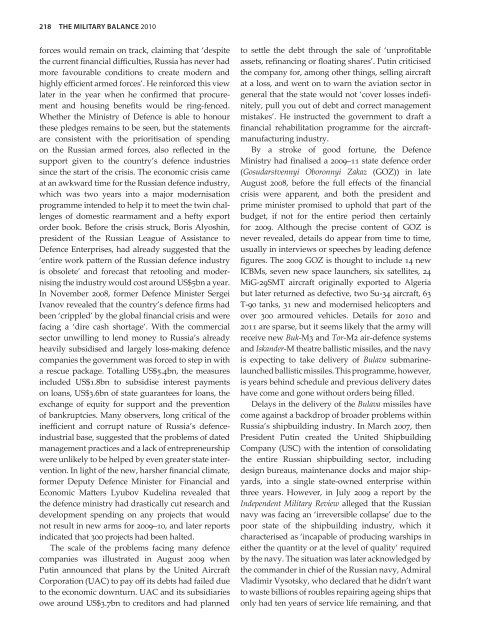Create successful ePaper yourself
Turn your PDF publications into a flip-book with our unique Google optimized e-Paper software.
218 The MiliTaRy Balance 2010<br />
forces would remain on track, claiming that ‘despite<br />
the current financial difficulties, Russia has never had<br />
more favourable conditions to create modern and<br />
highly efficient armed forces’. He reinforced this view<br />
later in the year when he confirmed that procurement<br />
and housing benefits would be ring-fenced.<br />
Whether the Ministry of Defence is able to honour<br />
these pledges remains to be seen, but the statements<br />
are consistent with the prioritisation of spending<br />
on the Russian armed forces, also reflected in the<br />
support given to the country’s defence industries<br />
since the start of the crisis. The economic crisis came<br />
at an awkward time for the Russian defence industry,<br />
which was two years into a major modernisation<br />
programme intended to help it to meet the twin challenges<br />
of domestic rearmament and a hefty export<br />
order book. Before the crisis struck, Boris Alyoshin,<br />
president of the Russian League of Assistance to<br />
Defence Enterprises, had already suggested that the<br />
‘entire work pattern of the Russian defence industry<br />
is obsolete’ and forecast that retooling and modernising<br />
the industry would cost around US$5bn a year.<br />
In November 2008, former Defence Minister Sergei<br />
Ivanov revealed that the country’s defence firms had<br />
been ‘crippled’ by the global financial crisis and were<br />
facing a ‘dire cash shortage’. With the commercial<br />
sector unwilling to lend money to Russia’s already<br />
heavily subsidised and largely loss-making defence<br />
companies the government was forced to step in with<br />
a rescue package. Totalling US$5.4bn, the measures<br />
included US$1.8bn to subsidise interest payments<br />
on loans, US$3.6bn of state guarantees for loans, the<br />
exchange of equity for support and the prevention<br />
of bankruptcies. Many observers, long critical of the<br />
inefficient and corrupt nature of Russia’s defenceindustrial<br />
base, suggested that the problems of dated<br />
management practices and a lack of entrepreneurship<br />
were unlikely to be helped by even greater state intervention.<br />
In light of the new, harsher financial climate,<br />
former Deputy Defence Minister for Financial and<br />
Economic Matters Lyubov Kudelina revealed that<br />
the defence ministry had drastically cut research and<br />
development spending on any projects that would<br />
not result in new arms for 2009–10, and later reports<br />
indicated that 300 projects had been halted.<br />
The scale of the problems facing many defence<br />
companies was illustrated in August 2009 when<br />
Putin announced that plans by the United Aircraft<br />
Corporation (UAC) to pay off its debts had failed due<br />
to the economic downturn. UAC and its subsidiaries<br />
owe around US$3.7bn to creditors and had planned<br />
to settle the debt through the sale of ‘unprofitable<br />
assets, refinancing or floating shares’. Putin criticised<br />
the company for, among other things, selling aircraft<br />
at a loss, and went on to warn the aviation sector in<br />
general that the state would not ‘cover losses indefinitely,<br />
pull you out of debt and correct management<br />
mistakes’. He instructed the government to draft a<br />
financial rehabilitation programme for the aircraftmanufacturing<br />
industry.<br />
By a stroke of good fortune, the Defence<br />
Ministry had finalised a 2009–11 state defence order<br />
(Gosudarstvennyi Oboronnyi Zakaz (GOZ)) in late<br />
August 2008, before the full effects of the financial<br />
crisis were apparent, and both the president and<br />
prime minister promised to uphold that part of the<br />
budget, if not for the entire period then certainly<br />
for 2009. Although the precise content of GOZ is<br />
never revealed, details do appear from time to time,<br />
usually in interviews or speeches by leading defence<br />
figures. The 2009 GOZ is thought to include 14 new<br />
ICBMs, seven new space launchers, six satellites, 24<br />
MiG-29SMT aircraft originally exported to Algeria<br />
but later returned as defective, two Su-34 aircraft, 63<br />
T-90 tanks, 31 new and modernised helicopters and<br />
over 300 armoured vehicles. Details for 2010 and<br />
2011 are sparse, but it seems likely that the army will<br />
receive new Buk-M3 and Tor-M2 air-defence systems<br />
and Iskander-M theatre ballistic missiles, and the navy<br />
is expecting to take delivery of Bulava submarinelaunched<br />
ballistic missiles. This programme, however,<br />
is years behind schedule and previous delivery dates<br />
have come and gone without orders being filled.<br />
Delays in the delivery of the Bulava missiles have<br />
come against a backdrop of broader problems within<br />
Russia’s shipbuilding industry. In March 2007, then<br />
President Putin created the United Shipbuilding<br />
Company (USC) with the intention of consolidating<br />
the entire Russian shipbuilding sector, including<br />
design bureaus, maintenance docks and major shipyards,<br />
into a single state-owned enterprise within<br />
three years. However, in July 2009 a report by the<br />
Independent Military Review alleged that the Russian<br />
navy was facing an ‘irreversible collapse’ due to the<br />
poor state of the shipbuilding industry, which it<br />
characterised as ‘incapable of producing warships in<br />
either the quantity or at the level of quality’ required<br />
by the navy. The situation was later acknowledged by<br />
the commander in chief of the Russian navy, Admiral<br />
Vladimir Vysotsky, who declared that he didn’t want<br />
to waste billions of roubles repairing ageing ships that<br />
only had ten years of service life remaining, and that


